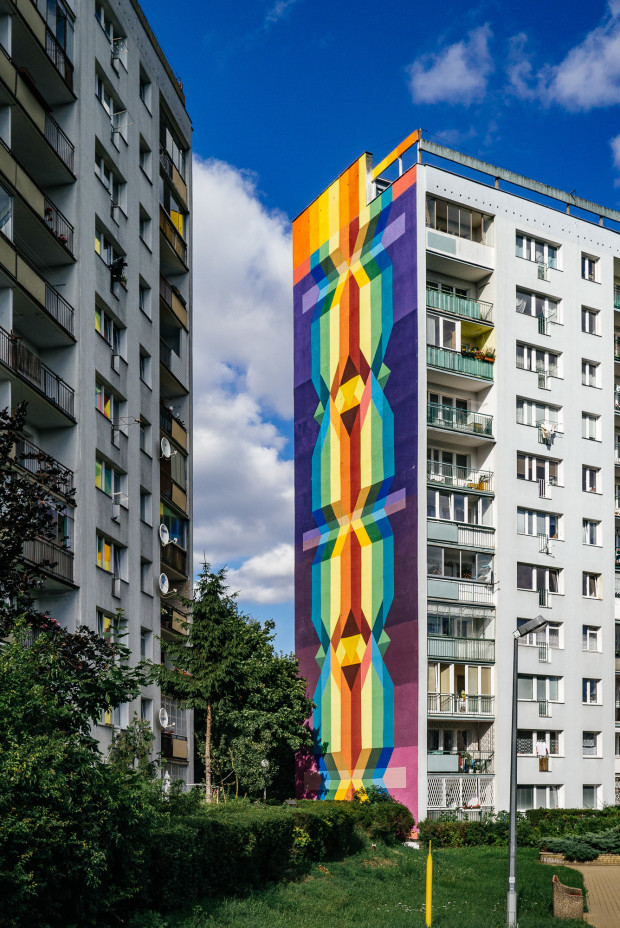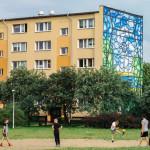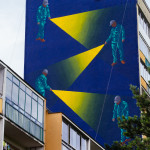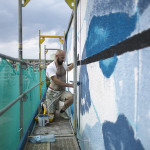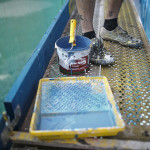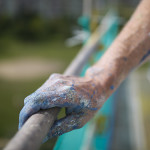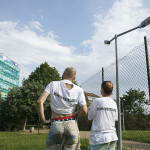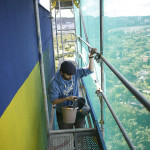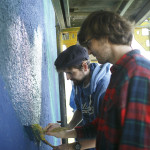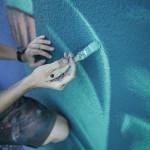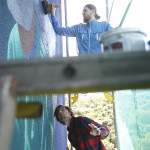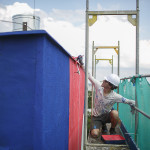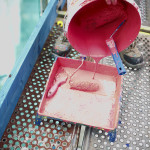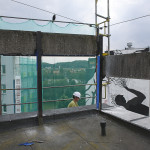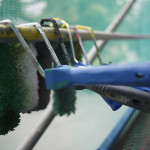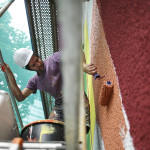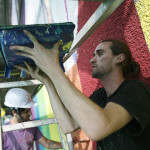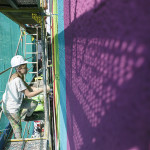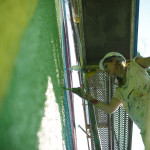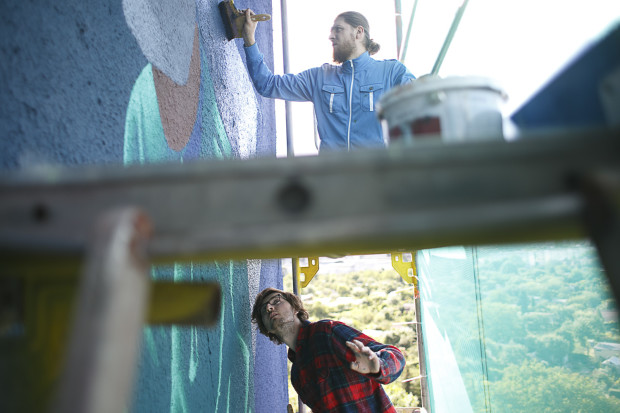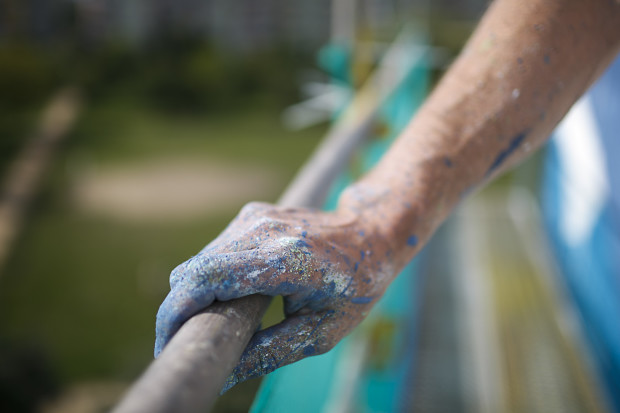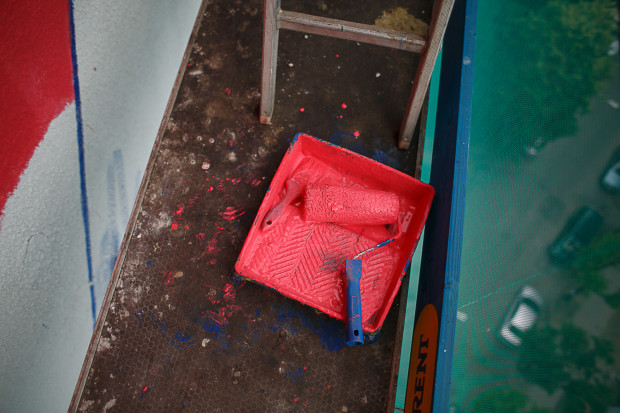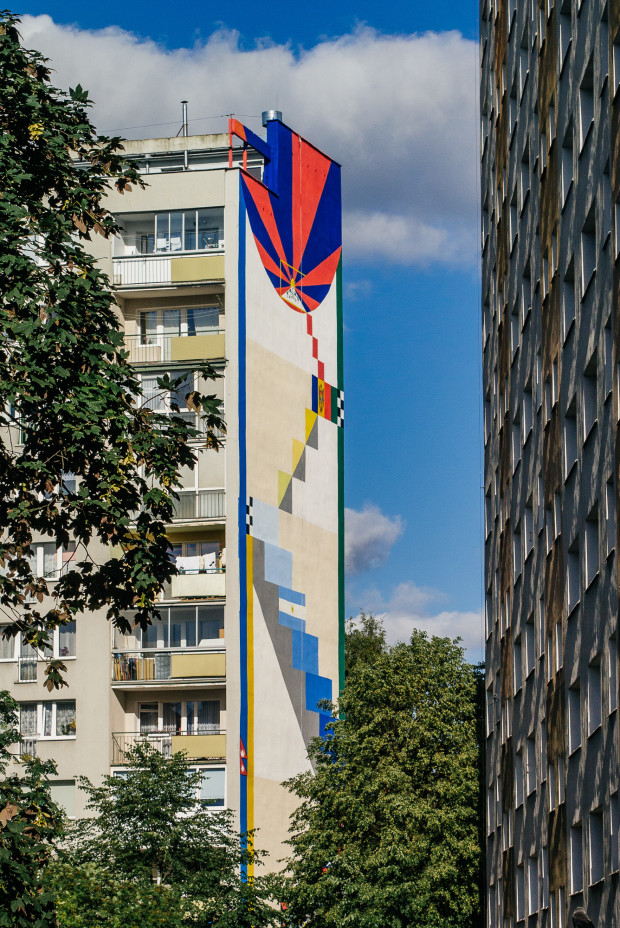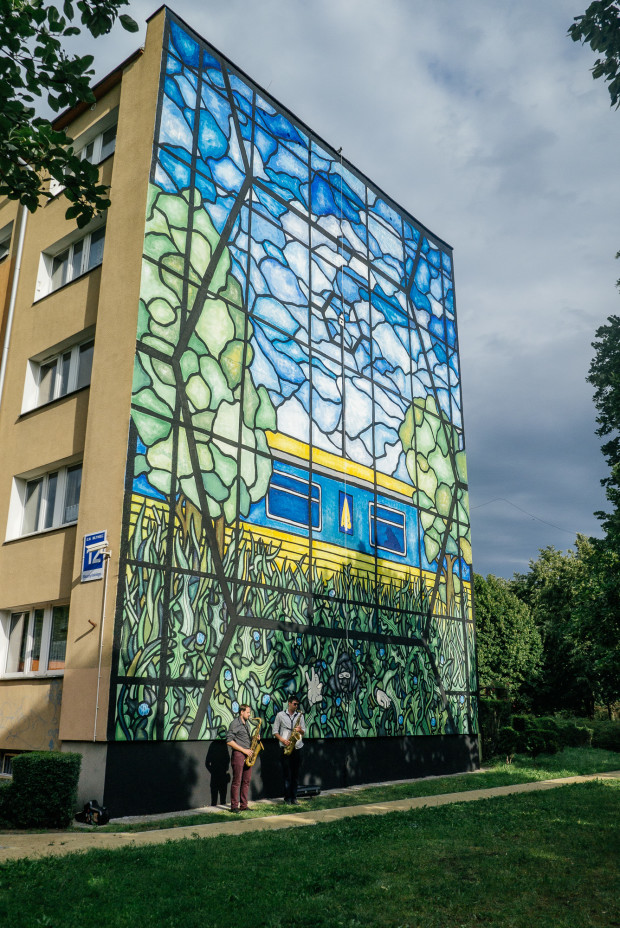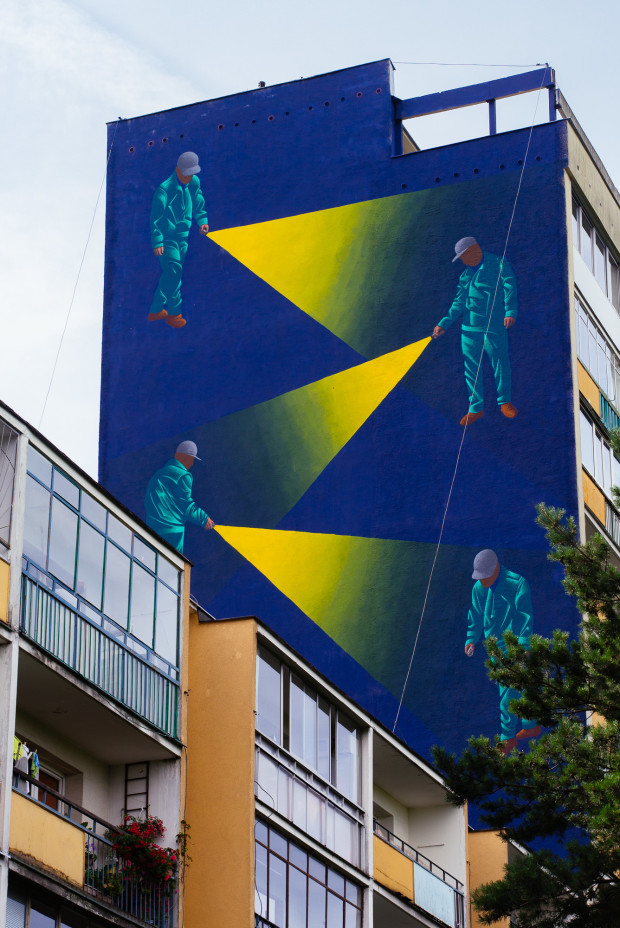What are they waiting for, what did they paint and how was it to work on the scaffolding reaching 12 floors? On July 8, Monumental Art Collection in Zaspa expanded with 4 murals, which altogether gives 58 large-format works. The eighth and the last edition of Monumental Art organized by City Culture Institute was seen off by over one hundred people. The parade, accompanied by live music, followed the traces of murals, which have been changing Zaspa for almost 20 years.
This time we invited two Argentinian artists: Jorge Pomar and David Petroni, and Polish artists: Kamil Kuzko and a team which was executing Dariusz Milczarek’s project: Jan Podgórski, Tomasz Prymon, Artur Prymon. They immediately jumped on the scaffolding, but between multiple brush strokes they found some time to talk to us. They made an attempt to relate to this year’s theme Waiting. Anna Żbikowska, CCI intern, talked with the artists.
Kamil Kuzko, Skarżyńskiego 12d
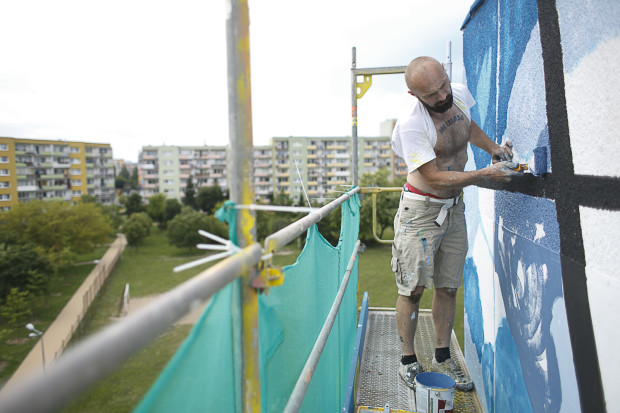
Anna Żbikowska: Why did you decide to use stained glass technique?
The themes of journey, commuter rail, carriages, suitcases, elements connected with trains in general, have been appearing in my works for about eight, nine years. Why is it so? There are plenty of reasons. I am a person who loves trains, including commuter rail. I have recently given up on employing these motifs: trains, journeys, waiting rooms, but it is my thing, my passion, something which still comes back. While speaking about murals, it feels like I came here, I am leaving soon and I am going somewhere else. Murals are strictly connected with travelling.
You used to go for black and white aesthetic before.
Yes, this is my first work, which is so colourful. I have never painted a wall in such a way.
I have never used the colours so bravely. It’s true that usually I play with illustration forms in more soft colours, quite limited colour gamut, cold grey shades. A solid, clear drawing mainly. But the time has come to make a change, try something new. For over a year I was really hoping to execute such a project, there were some places where the stained glass work was supposed to appear, but Zaspa tuned out to be the first stop to do it.
It isn’t the last time you reached for the colours, then?
Yes, I don’t think it is. I am not sure if I am going to execute walls in such a way though.
I wanted to face with such a fulgent project, which gained me much satisfaction. I think
I accomplished what I aimed for. The walls, which I am going to deal with in the future, will be slightly different.
What are you waiting for?
I am waiting for new stained glass projects. I would love to explore and then employ this technique. It’s another challenge and maybe I will succeed in creating some smaller forms in public space.
I read a passage about your works saying: “Both graffiti, as well as street art, which he creates successfully (…) derive from his passion which is painting.” Has anything changed? How would you describe yourself?
I am a painter. Nothing else needs to be added. I don’t really get the street art phrase; there is no definition here. It’s convenient, because it’s popular. I accept forms, which use street art, but I don’t relate to this phenomenon. I paint using my brushes, rollers or sprays.
Dariusz Milczarek, Pilotów 20d
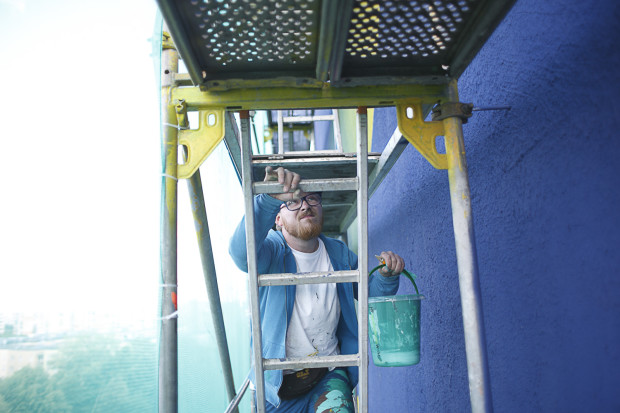
Anna Żbikowska: As a group you often take up sacred projects. What are the characteristics of sacred and secular painting?
Dariusz Milczarek: As Jerzy Nowosielski once said: “There is no such a thing like painting which isn’t sacred”, but still the difference is tremendous. While dealing with sacred painting we are fully dependent on the person who ordered the job. You start from the theme, and then there is a project. We don’t have that much freedom and possibilities, which we have here, in Zaspa.
The figures, which are reflected on the mural, refer to the Internet and 21st century. What’s you view on the phenomena? Is technology a blessing or a curse?
It’s hard to say, but it seems to me that we start to live a parallel life in the Internet. We create avatars, we become the engineers of our lives. We think we have a better control upon what is going on in the Internet than in a real world. In my opinion Internet, Facebook serve as propaganda of success. Seldom does someone post negative comments there, usually we come across information, which makes us feel better, and people who see it, usually envy us.
Doesn’t it trigger the wave of hatred among people who are jealous?
Yes, but on Facebook you can leave a positive comment only, it limits your hating options. You can stay indifferent, like something or comment it. I wanted to relate to this issue, because it is on my mind and I have many thoughts concerning this topic. Personally, I avoid selling my privacy; I don’t like propaganda of success. Even though I am on Facebook, my profile stays very limited.
What are you waiting for?
It’s really challenging to talk with an artist about what he is waiting for. An artist is waiting all the time. You wait for what happens next. Every time I finish a painting in my workshop,
I sense that something better is just around a corner. This feeling of constant need is
a trigger for further work. Waiting is strictly connected with creating as it leads to progress. Someone who stops and comes to the conclusion he has found what he was looking for, isn’t really related to creating process. Creating is a constant internal growth.
Jorge Pomar, Pilotów 17a
David Petroni, Pilotów 14f
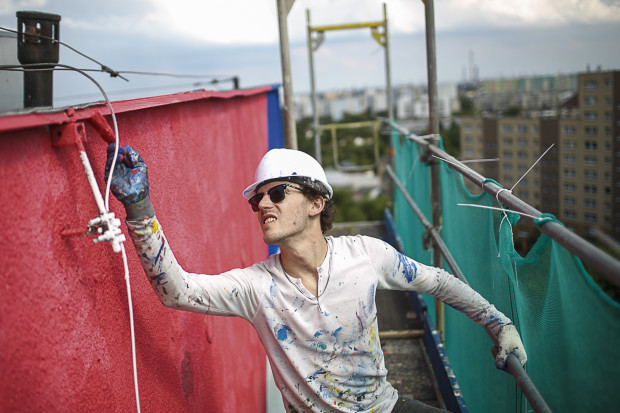
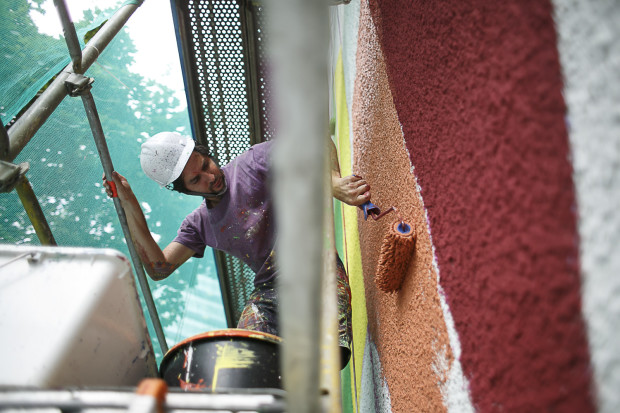
Anna Żbikowska: Are there any differences in the way people view street art in Poland and Argentina?
Jorge Pomar: I think that street art in Poland is still something new and people are not used to it. Here, in Zaspa, they react more positively, because they know that our works are part of the festival.
David Petroni: In Argentina you can just paint whenever you want to, people don’t mind and they accept it. I was in Rome some time ago and found it really difficult to paint, because Rome is a place with ancient history, many buildings or monuments are protected.
Have you been to Poland or Europe before?
JP: It’s my first time in Gdańsk, but I was in Poland before, I visited Poznań, and I am heading to Warsaw for three weeks soon. I absolutely love it in here. In my opinion Monumental Art Festival is one of the best events I have ever taken part in.
DP: It’s my first time here, so far we didn’t have time to visit Tricity, we work all day.
I hope to do some sightseeing after the opening.
David, what inspired you to use these particular colours and patterns? Why is tree playing the essential role in your project?
DP: The tree I am painting relates to Gdańsk. It is a conifer tree, and the colours symbolise Polish climate. Moreover, amber, which is a protection element of a tree, is commonly connected with the region of Baltic Sea. Amber fossilises with time and it needs to be rebuilt and it reminds me of Gdańsk as a city. It was destroyed, fossilised and it had to be reconstructed.
Are you up to something else apart from painting?
JP: Both of us take up murals, drawings, ceramics, photos, and videos. Art in the wide sense.
Jorge, why have you chosen these particular flags?
JP: I picked flags, which contain the element of sun. I use many geometric shapes: circles, triangles etc., but circle is a very special shape for me as it represents unity and life in Buenos Aires, where the sun always shines and we don’t have winter. When I get up and see the sun
I know the day will be great.
On what basis do you put the flags together?
JP: I always get the details about the building I am going to work on first and then I prepare the project. It is the first time I am creating something that big, 12 floors. I want the elements to look like a ladder, which tries to reach the sun.
What are you waiting for?
JP: For the sun to come up ever day.
DP: I would like to make a living as an artist and travel all over the world.
Artists were assisted by the students from Academy of Fine Arts and as Jorge says – They are solid warriors. Weronika, who helped David, complements the artists back – They are extremely ambitious, hard working and serious about what they do.
